PCC 8.16 Release
In the second quarter of 2021, PCC will release version 8.16 of our electronic charting and practice management software to all PCC users.
PCC 8.16 completes the first set of CHADIS integration features in PCC EHR. If your practice uses CHADIS, you can now automatically send patients and families questionnaires through the patient portal and receive results right inside your orders on the chart note. Additionally, appointment notes are now available on the PCC EHR schedule screen, and PCC 8.16 includes many other features and improvements.
Watch a CHADIS Video: Want to learn about PCC’s CHADIS integration updates in PCC 8.16? Watch the Configure CHADIS in PCC EHR.
Read below to learn more, and contact PCC Support for information about these new features or about any PCC product or service.
Contents
- 1 Review CHADIS Questionnaire Results in the Patient’s Chart
- 2 View Appointment Notes on Your PCC EHR Schedule
- 3 Add a Custom Summary to Direct Secure Messages
- 4 Request Attachments in Portal Message Templates
- 5 Look Up and Import Immunization Records from Your State’s Registry
- 6 Securely Retrieve Patient Information from Hospitals and Other Practices
- 7 Use the Latest SNOMED-CT Descriptions
- 8 Continue to View Productivity Data in Your Practice Vitals Dashboard
- 9 New and Updated Reports in PCC 8.16
- 10 New and Updated Interfaces Available in PCC 8.16
- 11 Updates to Immunization Forecasting
- 12 Other Feature Improvements and Bug Fixes in PCC 8.16
Review CHADIS Questionnaire Results in the Patient’s Chart
Results for CHADIS screenings can now appear automatically in a visit’s chart note.
When your patients, families, and other users complete CHADIS questionnaires, those results are sent to PCC EHR. You can review CHADIS results directly on the chart note without logging in to CHADIS.
First, your practice adds CHADIS questionnaires to screening orders in the PCC EHR Protocol Configuration tool.
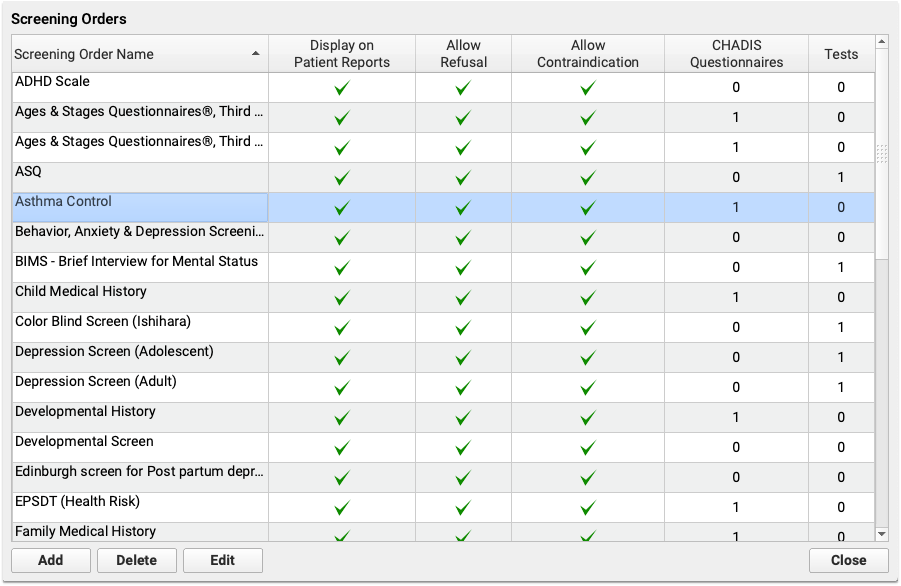
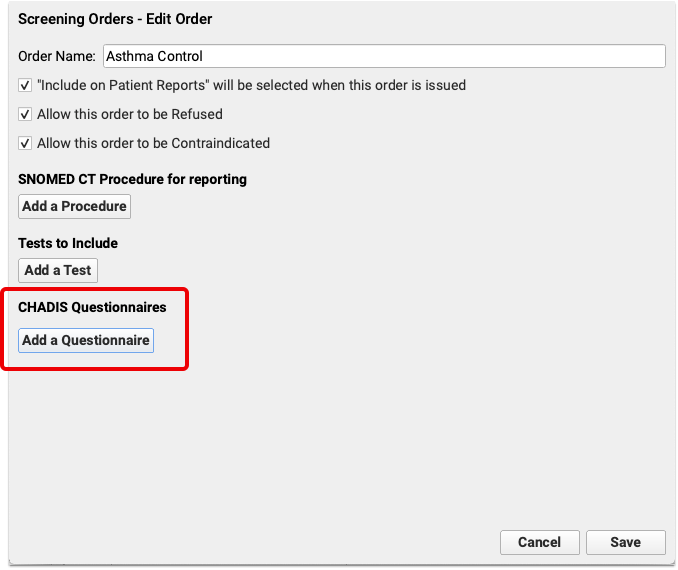
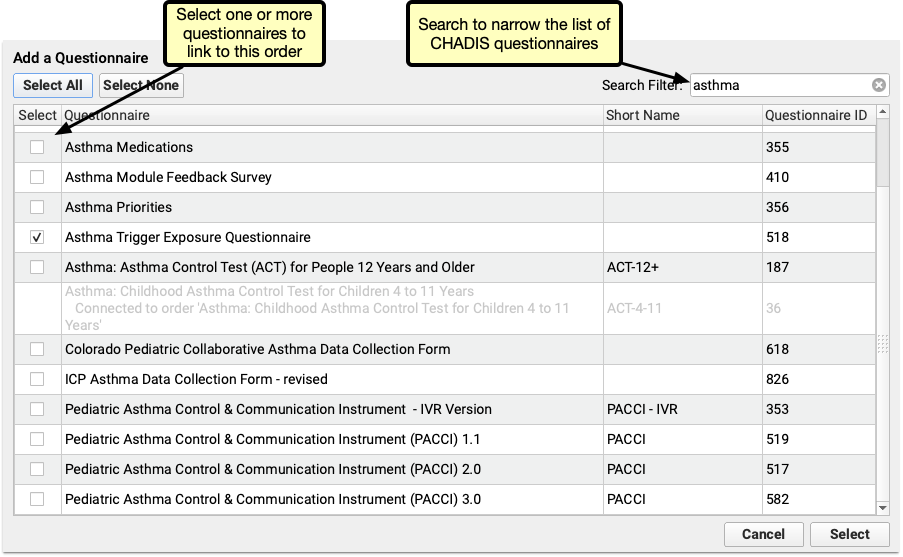
When new results arrive, they’ll be matched to the screening order in the patient’s visit.
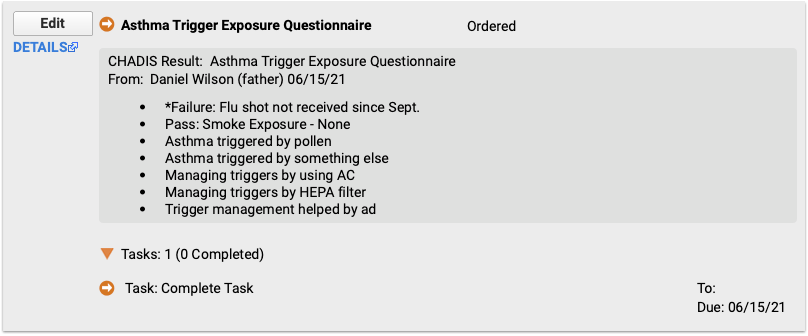
Your practice can use tasks and task tracking, like the orange ball on the Schedule screen, to make sure every result is reviewed. A task will be automatically scheduled for the visit date. You can review results and enter notes even before the patient has arrived.
Read the Full Article: For an in-depth walk-through of setting up and managing CHADIS results, review the Configure CHADIS Results article.
View Appointment Notes on Your PCC EHR Schedule
As you review today’s schedule, you can quickly review appointment notes for each encounter.
If an appointment has an appointment note, you will see a triangle in the Visit Reason column.


Click anywhere on the visit reason to show the note.
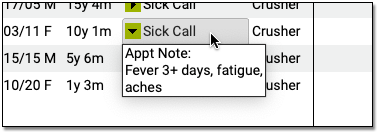
Visit Type Color Code: If your practice defines visit types by color, then the appointment note triangle will also display the color of the visit type. That means anyone at your practice can quickly see which appointments are sick, well, or consults, for example. You can configure Visit Types in the Visit Reasons Editor.
Add a Custom Summary to Direct Secure Messages
In PCC 8.16, you can add your own summary to a Direct Secure Message and reference it later from the patient’s Visit History.
Start by linking a Direct Secure Message to a patient. You can learn how to do that in the article Receive a Direct Secure Message and Add It to a Patient’s Chart.
Once the message has been linked to a patient, write a brief description of its contents in the “Summary” field at the top of the window.
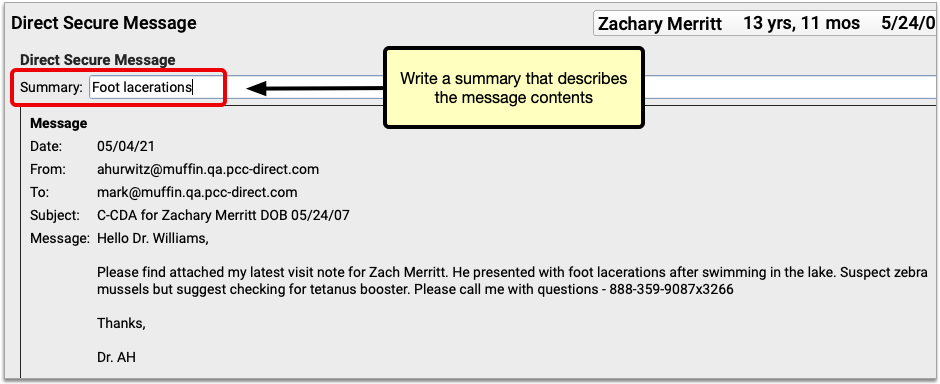
After you save and exit, the message appears in the patient’s Visit History with your custom summary.

If you choose not to write a summary, the message’s original subject will appear in the patient’s Visit History. You can revise a custom summary at any time by editing the Direct Secure Message.
Request Attachments in Portal Message Templates
Receive multiple documents directly from your patients and families through your Patient Portal Message system.
When you create a new Secure Messaging Template through PCC EHR’s Patient Portal Configuration window, you have the option to add a new component that includes an “Attach a Photo or PDF” button, so that you can make a specific request and the recipient can include the attachment in line with the message.
Open Patient Portal Configuration from PCC EHR’s Configuration menu and click the Message Templates tab. When editing or adding a new message, you’ll find a new “Attachment” component in the Build Template menu.

Add as many Attachment components as you’d like, alongside any other components.
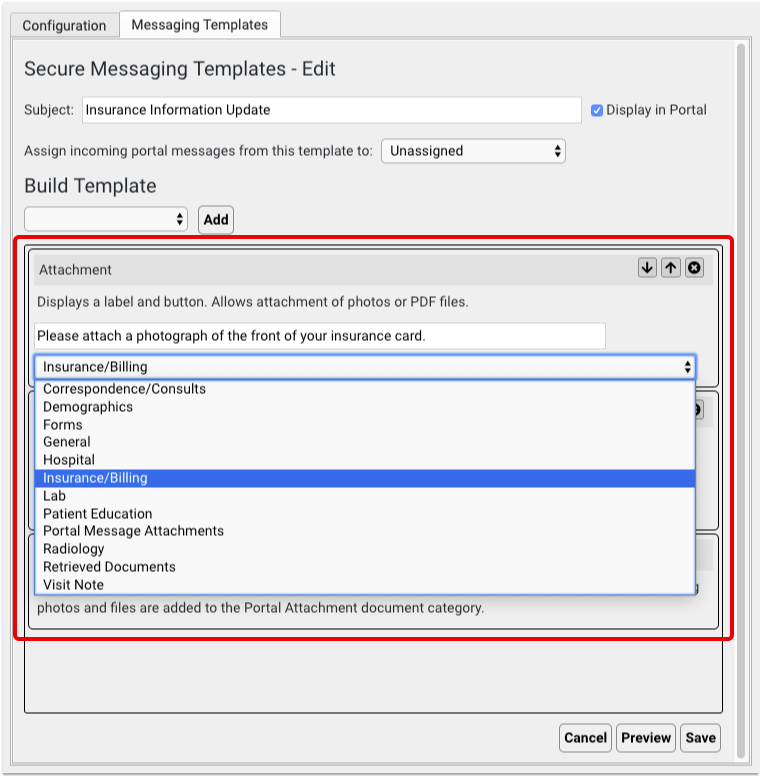
For each attachment component, you can select a document category for the requested document.
When your patient or family sends a message to you, they’ll have the opportunity to attach their PDF or photos in line with their message.

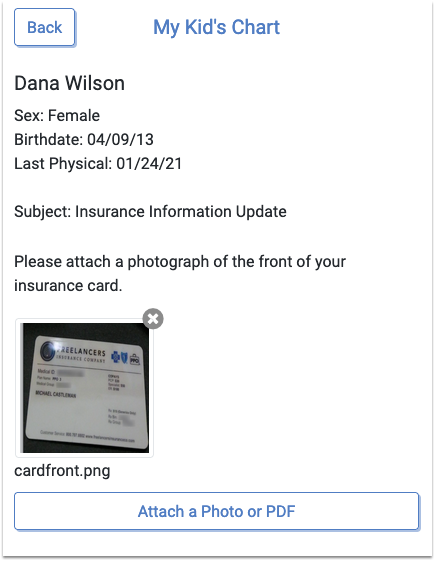
You’ll find those attachments in PCC EHR’s Messaging queue, as usual. The list of files will appear below the message text, in the same order as the components were uploaded.
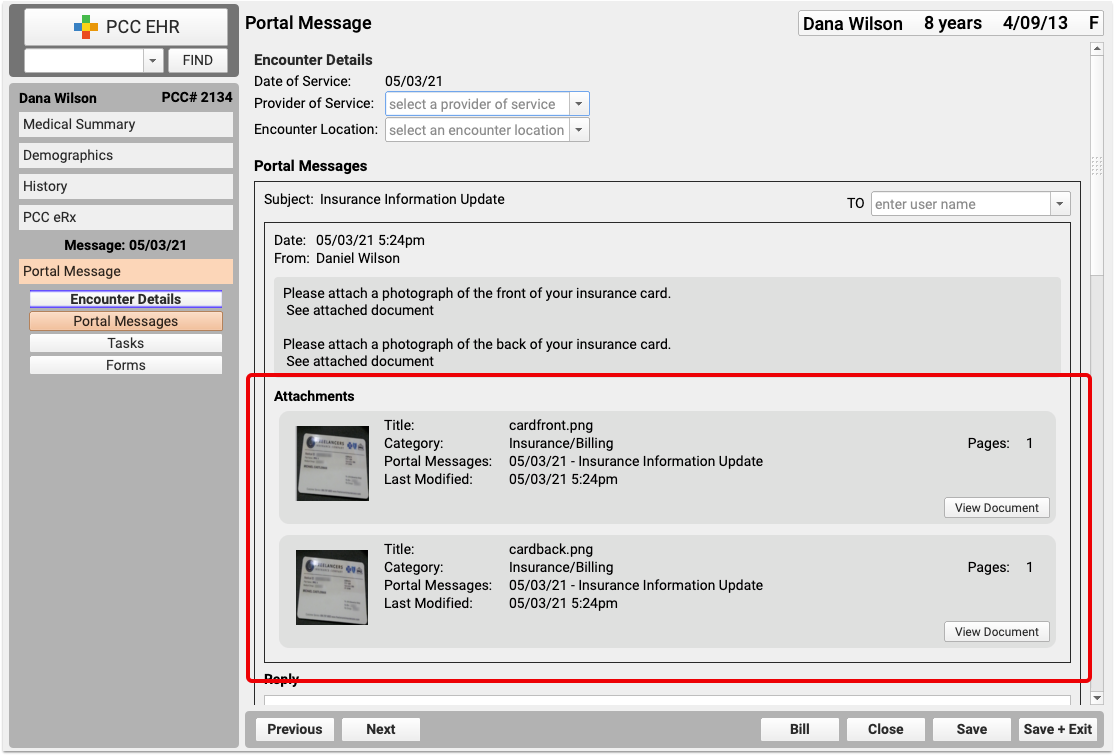
Look Up and Import Immunization Records from Your State’s Registry
Practices in California, Wyoming, Indiana, and Florida are now eligible to sign up for bidirectional connections with their state immunization registries.
With a bidirectional connection, you can look up and import vaccine records from your local immunization registry within your patient’s chart in PCC EHR.

To read about how it works, check out Look Up and Import Patient Immunization Records from Your Local Registry.
Contact PCC Support to get started, or to let us know that you’re interested in establishing a bidirectional connection with your registry once it’s available in your region.
Securely Retrieve Patient Information from Hospitals and Other Practices
Pilot testers can request and securely retrieve their patients’ records from other healthcare organizations on demand within PCC EHR. This is the latest addition to PCC’s Clinical Document Exchange functionality.
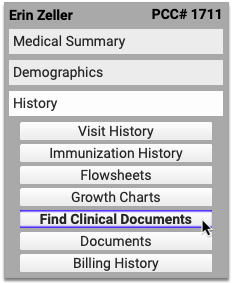
Read all about how to retrieve clinical documents on demand from other healthcare providers in the article Securely Retrieve Patient Information from Hospitals and Other Practices.
Use the Latest SNOMED-CT Descriptions
During the PCC 8.16 release cycle, PCC updated your practice’s system with the latest SNOMED-CT code set. You can read about the changes in PCC’s April 2021 SNOMED-CT Update article.
Continue to View Productivity Data in Your Practice Vitals Dashboard
PCC 8.16 removes the red COVID-19 banner from the front page of the Practice Vitals Dashboard. You can continue to view your practice’s daily productivity data and trends on the Dashboard’s COVID-19 page.
New and Updated Reports in PCC 8.16
With each release, PCC improves upon the reports you can generate in PCC EHR. Here are the reporting updates for PCC 8.16:
-
Better Time Format When You Export Appointment Reports to CSV: When you export an appointment report to comma-separated value format (CSV), the appointment time column is now formatted for easy import into your favorite spreadsheet program.
-
Optionally Add Appointment IDs to Your Appointment Reports: Sometimes you need to include an appointment’s unique ID number on a report, especially when sending appointment lists to a third-party appointment notification vendor. In PCC 8.16, you can add a column for unique appointment ID to your appointment reports.
-
Find Documents that Need to be Signed: Run the Document Modification report to find documents that have been (or need to be) signed. Use the “Signature Requested” field to find documents where no signature was requested, or where a signature was requested from a particular provider. And use the new “Signed By” field to see who signed a particular document.
-
See When Patients Were Added to PCC EHR: In PCC 8.16, the Patient List, Broadcast Messaging Patient List, Preventive Care Recall, Patients Overdue for Weight Management, and Chronic Condition Recall stock reports in the PCC EHR Report Library allow you to see when patients were added to PCC EHR. You can filter these reports and their custom versions by the date that patients were added to PCC EHR, or simply add a column to the output that shows you when patients on the list were added to your system.
New and Updated Interfaces Available in PCC 8.16
With each release, PCC expands and updates direct connections, partnerships, and integrations with insurance payers, immunization registries, and more. Here are the clinical and financial interoperability updates for PCC 8.16:
-
New and Updated Immunization Interfaces: During the PCC 8.16 release cycle, PCC updated our immunization registry submission interface with ShowMeVax (Missouri), and added the ability to request patient immunization records from WyIR (Wyoming), CHIRP (Indiana), and Florida SHOTS state immunization registries.
-
New Insurance Eligibility and Financial Interfaces: During the PCC 8.16 release cycle, PCC enabled real time insurance eligibility-checking for Maryland Physicians Care (payer ID 76498).
If your practice would like to take advantage of these connections, or you have another interface need, contact PCC Support.
Updates to Immunization Forecasting
Shortly after your office updates to PCC 8.16, you will receive a behind-the-scenes update to the immunization forecaster. These are the immunization forecasting updates for PCC 8.16:
-
No Waiting Period After COVID-19 Vaccine: The immunization forecaster will now allow for co-administration of other vaccines with the COVID-19 vaccine without a 14-day waiting period.
-
Forecasting Added for COVID-19 Vaccine: Administrations of the Johnson & Johnson (CVX 212), AstraZeneca (CVX 210), or Novavax (CVX 211) COVID-19 vaccine will now be reported in the immunization forecaster. Additionally, a COVID vaccine will now be recommended for patients 12 years and older.
-
Forecasting Added for Ebola Vaccine: Patients who receive a vaccine in the ebola family, including the Ebola Zaire vaccine (CVX 204) or an unspecified ebola vaccine (CVX 214), will present as up-to-date for ebola vaccination in the immunization forecaster.
-
Forecasting Added for MenQuadfi: Administrations of the MenQuadfi meningococcal polysaccharide (groups A, C, Y, W-135) TT conjugate vaccine (CVX 203) will now be reported in the immunization forecaster, and will trigger a forecast for the next dose based on the patient’s age and place in the series.
PCC updates the immunization forecaster throughout the release cycle. If you have questions or encounter issues with your immunization forecasting, contact PCC Support.
Other Feature Improvements and Bug Fixes in PCC 8.16
In addition to the features described above, PCC 8.16 includes these smaller improvements and squashed bugs.
-
COVID-19 Vaccine VIS Entry Updates: During the PCC 8.16 release cycle, multiple updates occurred for the VIS listings for COVID-19 vaccines. These updates did not always follow the normal standards, and in fact re-used identification numbers. These issues were corrected by the CDC in May, so PCC patched all client systems with the May VIS update for COVID-19 vaccines.
-
Puerto Rico: You can now select Puerto Rico, with the abbreviation PR, as a state in demographics in PCC EHR.
-
Handling of Relinked $0 Payments: In rare cases, when a payment was posted during check-in and then relinked to multiple charges in the Correct Mistakes (
oops) program with part of the payment being $0, payments could fail to apply properly. This will no longer occur. -
Care Center Assignment Improvements: Under certain circumstances, removing a patient’s care center assignment while also adjusting other status flags could result in the patient remaining in the care center. Additionally, new patients assigned care centers sometimes did not receive the corresponding status flag. PCC fixed these issues in PCC 8.16.
-
Phone Notes on Messaging Queue: For practices who use care centers, sometimes a phone note for a patient with no care center assigned would not appear properly on the Messaging queue. PCC patched this on all practice systems that use care centers in May of 2021.
-
TOS Adjustments with Copays: When a user posted a charge that would be written off by a capitation adjustment that also had a copay, an overpayment could sometimes result, which could then be recorded as a negative payment. PCC corrected this in PCC 8.16.
-
Insurance Address Issues: Under rare circumstances, when editing the address for an insurance plan, the table interface could freeze. PCC 8.16 corrects this issue.
-
Dashboard Corrections: During the PCC 8.16 release cycle, PCC corrected a calculation for patients who are overdue for a well visit, as well as an issue which could result in a 0% score for seasonal flu vaccine rates.
-
Patient Portal Messages in pocketPCC: Patient Portal messages in pocketPCC are now clearer and easier to read.
